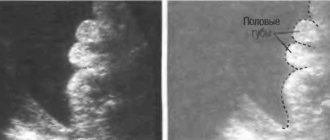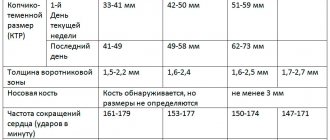Of course, any expectant mother wants to see how the child develops in the womb, whether he has any defects or malformations. Lately many people have been talking about 3D ultrasound during pregnancy.
Some people are hesitant to do such an ultrasound, fearing that it will harm the baby. However, there is no need to dismiss the idea of 3D ultrasound outright. Let's figure out what it is and what the advantages and disadvantages of this procedure are.
Is 3D ultrasound harmful during pregnancy?
Most obstetricians claim that ultrasound cannot cause harm and is absolutely safe. During the study, the level of ultrasound exposure is about 1% of the duration of the procedure, and the remainder is spent on processing and developing the received signals.
This procedure must be carried out as directed and under the supervision of a specialist. Any ultrasound, no matter what it is performed for, to identify possible defects or just to get to know the baby, should not be performed independently. Sometimes it is not clear to mothers why the doctor prescribes the procedure within a strictly defined time frame and cannot carry it out right away. This is due to the fact that there are periods that are determined by the Ministry of Health and they are of the greatest importance during pregnancy.
Despite doctors’ assurances about the absolute safety of the procedure, let’s look at it from a slightly different angle. To do this, you need to understand what ultrasound is. It is an elastic sound wave that is not perceived by the human ear. However, ultrasound itself is not considered something foreign to the body. Any ultrasound has an irradiating effect on the body, but ultrasound devices operate impulsively, which reduces the total exposure time. In addition, the area under study reflects about half of the ultrasound energy directed at the object under study.
In the 3D ultrasound procedure itself, it is difficult to find any serious threat to the health of the mother and child . How does all this go? The ultrasound emitter is collected into a narrow beam and directed to a certain place, and at this moment the doctor moves the device over the skin of the pregnant woman. The device also functions as a kind of scanner, which receives a signal and then transmits it to the screen.
Benefits of 3D Ultrasound
The main advantage of 3D ultrasound is its information content and accuracy. With such a study, it is possible to examine the fetus in three-dimensional format, to more accurately and in detail assess the structure of its internal organs, their structure, location, size, and so on.
As an additional advantage, we can mention that after a 3D ultrasound, parents can be given a three-dimensional photo of the baby and a short video about his life inside the mother’s belly on an electronic medium.
What pathologies does 3D ultrasound detect?
When deciphering the results of a three-dimensional scan, the following pathologies can be identified:
- Chromosomal disorders. Down syndrome, Edwards syndrome (trisomy on the 18th chromosome leading to a complex of developmental disorders of the cardiovascular system, central nervous system, gastrointestinal tract, etc.), Patau (trisomy on the 13th chromosome, also leading to a complex developmental disorder of most internal systems of the fetus) .
- Various heart defects.
- Malformations of facial bones and tissues – cleft lip, cleft palate.
- Genetic abnormalities, such as Smith syndrome.
- Defects in the development of the neural tube of the unborn child.
- Pathological increase in the volume of the fetal head (hypertensive-hydrocephalic syndrome).
- Complete absence or deformation, underdevelopment of internal organs.
What is the difference between ultrasound and 3D ultrasound?
The difference between 3D ultrasound during pregnancy and conventional two-dimensional ultrasound is that a special sonar is used for three-dimensional scanning. It combines three emitters and three receivers of reflected waves. A special algorithm is used for processing the signals received by the sensors, which makes it possible to form an accurate and stable high-resolution three-dimensional image of the fetus.
The fetus is examined in three traditional dimensions - height, depth, width.
High radiation intensity is also what distinguishes 3D ultrasound from conventional two-dimensional ultrasound. There is an opinion that, due to such intensity, 3D ultrasound can harm the unborn child, although in practice no reliable evidence of this fact has been found.
#!UZIseredina!#
3D ultrasound procedure and its advantages
3D ultrasound has its advantages:
- makes it possible to identify various developmental defects that are not visible during a conventional ultrasound, for example, the number of fingers, facial defects, non-fusion of the spinal cord, etc.;
- the device displays a clearer picture, which allows you to quickly take measures to eliminate diseases;
- With a 3D ultrasound you can find out the sex of the child with 100% accuracy , since with a regular ultrasound you can confuse the genitals. Determining gender to a greater extent is not just a whim of parents, but to prevent the development of possible pathologies.
By the way, during the procedure you can take photos and even videos of the baby in the womb. This is very unusual and interesting, and it will remain a memory for many years.
What the 3D study shows
In general, the objectives of 3D imaging are not very different from those of ultrasound diagnostics. So, ultrasound in obstetrics is used to detect pregnancy:
- single and multiple;
- establishing the gestational age and expected date of birth (DAD);
- pathological conditions of the pregnant woman and the fetus (from congenital malformations of the child to inflammatory processes of the uterine appendages);
- uterine;
- determining the position of the baby in the uterus in the later stages.
3D scanning in early pregnancy (less than 12 weeks) is unlikely to be informative.
But when the twentieth or more weeks pass after conception, three-dimensional ultrasound will prove useful in diagnosing many anomalies. So, a 3D examination during pregnancy is indicated if external malformations of the fetus are suspected: dysplasia, facial and body deformities, altered number of fingers, etc.
These assumptions can arise both from data from other studies (perinatal screening) and from pathology in close relatives. In addition, three-dimensional scanning should be done for women with a burdened obstetric and gynecological history, patients after IVF, ICSI, MESA, and with multiple pregnancies. In addition, the procedure is also prescribed for those with a family history of sex-linked diseases. In this case, finding out who the future embryo is - a boy or a girl - will not be difficult already at 10-14 weeks. In the above conditions, pregnant women undergo 3D ultrasound of the fetus free of charge.
Price for 3D ultrasound
The procedure costs from 40 to 100 dollars , the amount depends on many factors - the region, the qualifications of the specialist, the reputation of the medical center, etc. There is still no unanimous decision among doctors, some believe that the procedure is extremely positive, and some believe that such an examination should be carried out only in case of special indications, but not during a standard examination.
Another important question that future parents face is where to get a 3D ultrasound ? Now most medical centers provide this service. The main thing is to find a good master whom you can trust and be confident in his professionalism. If in your city none of the clinics provides this service, then you can do a 3D ultrasound in Moscow or in another regional center.
3D and 4D ultrasound - what is the difference?
Ultrasound examination of the fetus is a mandatory examination included in the pregnancy management program.
At the AltraVita Human Reproduction Clinic, patients are recommended to undergo a comprehensive examination using expert-class devices. Thanks to the high resolution of the technique, the sonologist can clearly see congenital anomalies, multiple or ectopic pregnancies. According to current recommendations, every expectant mother should undergo this examination two to three times during the entire period of pregnancy. If necessary, the number of inspections is increased. In particular, the doctor may recommend additional ultrasound before childbirth to choose the method of delivery.
However, today, in addition to conventional ultrasound examination, 3D and 4D ultrasound are used. What is the difference between these procedures, and how necessary are they?
Reviews about 3D ultrasound
Mothers who have already done a 3D ultrasound are in a hurry to share their impressions with others. Here's what they say:
- Maria: “I had this ultrasound at 19 weeks. The doctor who treated me was simply amazing. Everything was explained and explained in detail. I was lying down, and there was a monitor above my head, where the baby’s tiny arms and legs were visible. He even moved right in my tummy. The doctor took all the necessary measurements, and at the end they issued a conclusion about the ultrasound performed. The only thing I didn’t realize was that we could also make a video, but we still had some good photos. I paid 1,750 rubles for the entire service, which was quite acceptable. By the way, it is better to go for the procedure before 26 weeks, since then the baby simply may not fit on the screen. I advise everyone to try it, it’s great!”
- Oksana: “We did a 3D ultrasound at week 20, but we didn’t get good photos. Our baby turned away from us and covered her face with her tiny hands, feeling shy. The attitude at the hospital was very good. True, I didn’t like that the procedure lasted about half an hour, which was quite a long time for a baby, she even frowned and covered her ears with her hands. So if you do an ultrasound, it’s better to do it once; after all, it’s stressful for the baby.”
- Irina: “I recently did a three-dimensional and even four-dimensional ultrasound, but it didn’t work! The doctor explained this by saying that mothers who were prone to obesity before pregnancy are not recommended to do 3D and 4D examinations because they are hard to see. And you can become thin starting from 20 weeks.”
Tips for expectant mothers: where to get a 3D ultrasound of the fetus and is it safe?
The Optimus Center for Aesthetics and Health offers a worthy alternative to conventional ultrasound examination - three-dimensional ultrasound. During a traditional ultrasound, the image turns out flat and does not always give a complete picture of the condition of the fetus in the mother's womb. In addition, its results are often understandable only to a specialist, while parents have to be content with a dry conclusion. Three-dimensional ultrasound during pregnancy significantly improves image quality without losing its medical properties. 3D ultrasound is the first photos of your baby in the family album. At your request, the Optimus Center for Aesthetics and Health offers a video recording of an ultrasound examination on electronic media in 2D mode.
Advantages of three-dimensional fetal ultrasound
Three-dimensional ultrasound is an ultrasound examination that provides a three-dimensional image (in three dimensions) - in fact, a photograph of the fetus on a monitor screen, which can be printed (take a photo of a fetal ultrasound) and saved on disk in digital format.
The 3D mode allows you to assess the child’s condition with the greatest reliability and high level of image quality and exclude developmental pathologies and determine the gender. Typically, an ultrasound of the fetus produces a two-dimensional image - a section of tissue in the area of ultrasound action.
So what are the current capabilities of 3D ultrasound research? Unfortunately, in certain situations, conventional ultrasound examination is not enough.
First of all, we are talking about the possibility of visualizing certain facial defects, accurately determining the number of fingers and toes, non-fusion of the spinal cord,
the presence of congenital abnormalities of the skin or genital organs. In all these cases, future parents will be helped by a three-dimensional study. In addition, this study can help in determining the exact gender of the child, because the three-dimensional image allows you to see the whole child or enlarge the image of a specific part of the body. You can also see the child's face in close-up. Agree, wouldn't anyone be interested in the opportunity to receive a photo album with pictures of an unborn child? It is all these possibilities of three-dimensional research that attract future parents.
The three-dimensional ultrasound procedure includes two- and three-dimensional ultrasound examination of the fetus. The patient receives the results of the study - a doctor’s report, a printed color photo and a disk with a digital recording of the 3D ultrasound on the day of the study. In the absence of special indications, two or three sessions of 3D ultrasound during pregnancy will be sufficient.
Traditional ultrasound during pregnancy does not always allow one to accurately determine the sex of the unborn child, as well as identify possible anomalies in its development. Then 3D ultrasound comes to the rescue. Unlike conventional ultrasound, 3D ultrasound data provides additional information that allows you to diagnose many abnormalities in the fetus.
In addition, the combination of two-dimensional and three-dimensional fetal ultrasound is a unique diagnostic method that makes it possible to see the child as realistically as possible: the way he is, right down to his fingers and toes.
The first pictures in 2D mode can be taken when the length of your baby does not exceed 15 mm; at a period of 8 weeks, the head, torso, developing arms and legs can be easily distinguished. From 10 to 16 weeks of pregnancy, the entire fetus can be seen.
Thus, two-dimensional ultrasound makes it possible to characterize the condition of both mother and child. Data from 3D ultrasound of the fetus, which allows one to obtain a three-dimensional image, complement and clarify the image obtained in the traditional way.
Three-dimensional ultrasound is performed according to indications in cases of suspected fetal developmental anomalies or the presence of various neoplasms.
3D also makes it possible to examine individual parts of the body, facial features, which parent the child resembles, and it also provides a psycho-emotional connection between parents and baby. In gynecology, this type of examination is the latest diagnostic method, it allows you to determine the condition of the fetus and identify developmental anomalies in organs and systems, and examine the fetus in a three-dimensional projection (length, height, depth).
The results of the study are issued immediately after the procedure. This type of study is best carried out in the second half of pregnancy.
It is better to combine two-dimensional (2d) research and three-dimensional (3d). The latter only provides additional information to 2d. The optimal period is 25-30 weeks. The power of the ultrasound wave remains the same as in the 2d study.
How safe is 3D ultrasound?
There is an opinion among some parents that ultrasound examination has a negative effect on the fetus, but this is not the case. Three-dimensional ultrasound is recognized as safe and does not harm either you or your baby.
Ultrasound, used in medicine and obstetrics, is absolutely safe for both the expectant mother and the baby. This has been officially confirmed by clinical studies and many years of experience in use during pregnancy.
The safest are modern models of ultrasound scanners that have special gynecological and obstetric programs and calculations. Ultrasound examination of the fetus, including 3D ultrasound, does not have any negative effect on the fetus, and remains one of the safest and most informative methods for monitoring the intrauterine development of a child.
When is it recommended to undergo a 3D ultrasound?
You should try to perform ultrasound during pregnancy within strictly regulated periods - that is, when the diagnostic value of the method is especially high. In addition, the exposure time to ultrasound during a three-dimensional ultrasound of the fetus is only 1% of the time of the entire study. The rest of the time, the sensor receives reflected signals and processes the information.
Therefore, 3D ultrasound during pregnancy is as safe as 2D. Various types of anomalies that interfere with the normal course of pregnancy can also be detected using ultrasound. Among them are the threat of miscarriage, polyhydramnios or oligohydramnios, fetal malnutrition, and entanglement of the baby’s neck with the umbilical cord.
In order to promptly detect certain problems and avoid the development of pathology, ultrasound during pregnancy is recommended to be performed five times:
• the first one must confirm or deny the fact of pregnancy. In this case, an ultrasound is prescribed if there is a delay of five to seven days;
• a second ultrasound should be performed at 11-13 weeks;
• third time - at 16-18 weeks;
• fourth time - at 22-24 weeks;
• last, fifth time - at 32-34 weeks.
It is at all of the above stages that the child develops a risk of developmental defects. It is most optimal to conduct a three-dimensional 3D ultrasound examination from the 25th week to the 30th week of pregnancy.
In what situations is it difficult to see a child?
To the disappointment of future parents, sometimes a situation arises when it is difficult to see the child using an ultrasound. Let's try to figure out why this is happening:
• location of the umbilical cord and placenta;
• presence of scars on the abdomen after operations;
• the activity of the child (the image directly depends on how much he moves. That is, if the child is active, the quality of the frames will be more interesting, and the image itself will be clearer);
• overweight mother;
• incorrect position of the child in the womb;
• the amount of amniotic fluid (the more there is, the better the image on the screen during the ultrasound procedure).
By contacting the Center for Aesthetics and Health, you will have the opportunity to undergo an ultrasound quickly and in comfortable conditions. At your request, in addition to the examination, you can receive a video recording of the ultrasound examination on electronic media.
At your disposal are modern equipment and highly qualified ultrasound diagnostic specialists. You can ask your question or make an appointment with a doctor by calling or ordering a call on the company’s website.
By contacting the Optimus Center for Aesthetics and Health, you will have the opportunity to undergo an ultrasound quickly and in comfortable conditions. At your request, in addition to the examination, you can receive a video recording of the ultrasound examination on electronic media.
At your disposal are modern equipment and highly qualified ultrasound diagnostic specialists. You can ask your question or make an appointment with a doctor by calling or ordering a call on the website.
*As an advertisement











